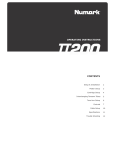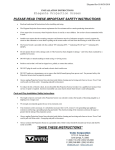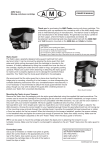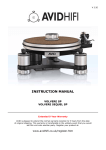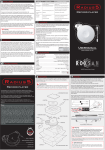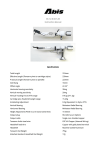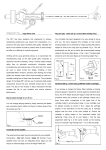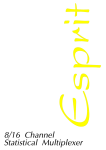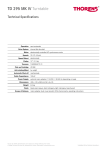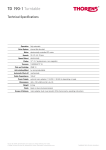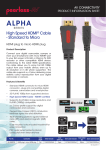Download User Manual - Pro-Ject Audio Systems
Transcript
INSTRUCTIONS FOR USE Pro-Ject SIGNATURE 10 Dear Music Lover, Thank you for purchasing a Pro-Ject Audio System’s record player. In order to achieve maximum performance and reliability with this record player you should study these instructions for use carefully. Warning of a hazard for the user, the unit or possible misuse Important notice During assembly and adjustment of the deck small parts could be lost if not carefully placed in a suitable receptacle. Before starting assembly make yourself acquainted with the parts listed on page 5 and correspondingly numbered in the technical drawings on next pages. Separately packed items are marked with an asterisk *. Your turntable was shipped partially disassembled in order to avoid damage to sensitive parts. Please check immediately to make sure that neither the packaging nor the device was damaged in transit. If damaged, please do not operate and contact your dealer. Disposal of packaging material: Pro-Ject packaging is carefully designed to protect your component from damage in transit and you are strongly urged to keep the original packaging in order to safely ship or otherwise transport your turntable in the future. However, the packaging materials were chosen to be environmentally friendly, so if you must discard the packaging, please recycle. Disposal of old equipment: If you’re disposing of old electronic equipment, please use a local waste facility designated for that purpose. Safety instructions The power supply is used to connect and disconnect the unit from the mains. Make sure that the plug is easily accessible at all times. Hold the plug when unplugging the power cord. Never handle the power cord while your hands are wet or damp. Avoid letting liquids enter the device. Never place any item containing liquid, such as a flower vase on or near the device. Never spill any liquid on the device. Never place any naked flame sources, such as lighted candles on or near the device. The product shall not be used in damp or wet locations, next to a bathtub, sink, swimming pool or any other similar conditions. Keep plastic bags away from children to prevent any risk of suffocation. 2 © Pro-Ject Audio Systems · Pro-Ject SIGNATURE 10 · Revision 2015.07.14 Contents Product illustrations 4 Control, features, connections 5 Turntable accessories 5 1. Platter installation 6 2. Drive belt installation 7 3. Tonearm assembly 8 Set-up a. Assembly of the main tonearm part on the uni-pivot tip 8 b. Tonearm output connector 8 c. Headshell installation 9 d. Counterweight installation 9 Operating and calibration 1. Cartridge setting 10-11 2. Vertical tracking force adjustment (VTF) 12 3. Setting range of the counterweight 13 4. Vertical tracking angle adjustment (VTA) 14 5. Anti-skating assembly and adjustment 15-16 6. Azimuth adjustment 17 7. Mounting distance adjustment 18 8. Levelling the turntable 19 9. Connecting the turntable, starting the motor, changing the speed 20 10. Technical specifications 21 11. Troubleshooting, warranty, service 22 12. Dimensions, exploded view of the packaging 23 © Pro-Ject Audio Systems · Pro-Ject SIGNATURE 10 · Revision 2015.07.14 3 4 © Pro-Ject Audio Systems · Pro-Ject SIGNATURE 10 · Revision 2015.07.14 Pro-Ject SIGNATURE 10 Controls, features and connections 1 2 3 4 5 6 7 8 9 10 11 12 13 14 15 Power supply socket Motor pulley Drive belt* Sandwich platter* Signature Record Clamp* ON/OFF switch, speed selector Tonearm counterweight* Anti-skating mechanism* Tonearm connector Tonearm lift lever Tonearm rest position Tonearm tube* Detachable Signature headshell* Transport screws 3x Magnetic adjustable feet Turntable accessories 1 2 3 4 5 6 7 8 9 10 11 12 13 14 15 2 pieces of anti-skating thread Single adapter Allen key 1,5mm Allen key 2mm Allen key 5mm Signal cable Connect IT 5P-CC (123cm, already connected to the tonearm) White cotton gloves Cloth Additional counterweight Ø15mm, length 30mm (Together with basic counterweight it balances cartridge with weights from 7,5 to 20 grams) Spirit level Tool for correct cartridge assembly Signature record puck Cartridge alignment protractor Universal power supply Instructions for use © Pro-Ject Audio Systems · Pro-Ject SIGNATURE 10 · Revision 2015.07.14 5 Set-up 1. Platter installation Unscrew the three transport screws (14) from the aluminium sub-chassis before installing the sandwich platter (4). Remove the protective covers from the bearing shaft and from the platter housing. These covers shield against dust and dirt and keep the bearing shaft and housing sufficiently lubricated. If necessary, lubricate the shaft with grease from the enclosed accessories. Maximum amount is 0,5 ml. Use the scale on the supplied syringe to measure the desired quantity and distribute the lubricant evenly. The platter is floating on magnets. Take care not to damage the magnet when putting the platter on the shaft. 6 © Pro-Ject Audio Systems · Pro-Ject SIGNATURE 10 · Revision 2015.07.14 2. Drive belt installation Fit the drive belt (3) around the platter (4) and the motor pulley (2). Avoid getting sweat or grease on the belt as these will deteriorate the performance and reduce the belt's lifespan. Use absorbent kitchen paper to remove any oil or grease from the outer edge of the platter and the belt. Do not stretch the belt too much. Please note: We recommend to use the record player without a mat on the platter. © Pro-Ject Audio Systems · Pro-Ject SIGNATURE 10 · Revision 2015.07.14 7 3. Tonearm assembly a) Assembly of the main tonearm part on the uni-pivot tip Carefully remove the main tonearm part from the packaging and put this part onto the tonearm uni-pivot tip. b) Tonearm output connector Insert the connector (9) carefully into the socket on the top of the tonearm. Positioning pin must be directed to the counterweight. When the connector is inserted, secure it by screwing the locknut clockwise. 8 © Pro-Ject Audio Systems · Pro-Ject SIGNATURE 10 · Revision 2015.07.14 c) Headshell installation Insert the headshell (13) into the front of the tonearm tube. Connector pin must be oriented into the groove in the tonearm tube. Secure the headshell by screwing the locknut clockwise. d) Counterweight installation Put the counterweight (7) on the support rod. Tighten the locking screw gradually and put the shaft entry into thread groove. Tighten the locking screw. A correction of counterweight’s weight is possible by the additional counterweight which is tightened by the set screw. © Pro-Ject Audio Systems · Pro-Ject SIGNATURE 10 · Revision 2015.07.14 9 Operating and calibration 1. Cartridge setting Install the cartridge into the aluminium headshell, using the appropriate hardware included with your cartridge. Connect the cartridge as indicated below: White Red Green Blue left channel L+ right channel R+ right channel Rleft channel L- For correct cartridge alignment, use the two-point cartridge alignment protractor provided with SIGNATURE 10 accessories. If unfamiliar with two-point setup, please refer to your dealer. Tonearm details: Effective length = 254mm (10”) (Distance between cartridge needle and the vertical rotation axis of the tonearm) Mounting distance = 238mm (Distance between spindle and the vertical rotation axis of the tonearm) 10 Outer null point: r = 63,4mm © Pro-Ject Audio Systems · Pro-Ject SIGNATURE 10 · Revision 2015.07.14 Setting the position of cartridge in the headshell For correct position of the cartridge in headshell grooves, use the small tool made out of transparent plexiglass. Please note that this tool is only useable for Pro-Ject Audio Systems‘ Signature tonearm headshells. Step 1: Place the tool with groove to the headshell as shown. Step 2: Move the cartridge to the correct position. Correct position is, if the top of the needle is in the same plane like as comparative plane of tool. This is illustrated in the following picture. © Pro-Ject Audio Systems · Pro-Ject SIGNATURE 10 · Revision 2015.07.14 11 2. Vertical tracking force adjustment (VTF) Place counterweight halfway along the counterweight support rod, being sure to have the locking screw uppermost. With the power off, platter static, place the stylus pressure gauge onto the platter. To set the required VTF place the tip of the stylus on the pressure gauge. Moving the counterweight towards the cartridge will increase VTF, away will reduce VTF. In order to avoid damage of the cartridge, all cartridge movements must be done in upper tonearm lift position. Repeat the measuring procedure until you achieved the correct VTF. 12 © Pro-Ject Audio Systems · Pro-Ject SIGNATURE 10 · Revision 2015.07.14 3. Setting range of the counterweight 1. Counterweight without additional weight (103g) This setting balances cartridges with weight from 4,5 to 8 grams. 2. Counterweight with additional weight. Dimensions of additional counterweight: Ø15mm, length 30mm, weight 42 grams. a) If additional counterweight is placed symmetrically (6mm out from both sides), it can balance cartridges with weight from 7,5 to 17 grams. b) If the additional weight is placed unsymmetrically (as shown in the picture bellow, 12mm visible part from the rear side), it can balance cartridges with weight of 17 to 20 grams. © Pro-Ject Audio Systems · Pro-Ject SIGNATURE 10 · Revision 2015.07.14 13 4. Vertical tracking angle adjustment (VTA) Put a record on the platter. When the needle is lowered into the record groove and the tonearm is not resting on the tonearm rest, the tube of the tonearm should be parallel to the surface of the record. If it is not, loosen both VTA locking screws in the tonearm base just enough to allow vertical movement of the arm pillar without force. By turning VTA adjustment screw set the correct vertical tracing angle. Carefully retighten VTA locking screws without applying excessive force which would deform the arm pillar. 14 © Pro-Ject Audio Systems · Pro-Ject SIGNATURE 10 · Revision 2015.07.14 5. Anti-skating assembly and adjustment The anti-skating mechanism is shipped partially disassembled to avoid damage during transport. For correct installation, please follow the steps below. Step 1: Prepare anti-skating sliding mechanism from the accessories bag. The anti-skating sliding mechanism is supplied with a pre-mounted anti-skating weight and thread for mounting on the tonearm. Step 2: Put the eye of the anti-skating thread around the hole for the HOOK SCREW and screw the HOOK SCREW into the tonearm through the eye of the anti-skating thread as shown in the illustration below. © Pro-Ject Audio Systems · Pro-Ject SIGNATURE 10 · Revision 2015.07.14 15 Step 3: Put the anti-skating sliding mechanism on the end of the anti-skating support rod. The anti-skating thread should fit into the groove in the tonearm. Be careful when handing the anti-skating thread in order to avoid damaging it. Step 5: Anti-skating force adjustment: Adjust the anti-skating force by positioning the weight on the appropriate groove of the anti-skating sliding mechanism. Anti-skating downforce should be adjusted in correspondence with the tonearm downforce as follows: Tonearm downforce: Lower than 13 mN or 1.3 grams 13–18 mN or 1.3–1.8 grams 18–25 mN or 1.8–2.5 grams 16 Anti-skating groove: 1st groove from bearing 2ndgroove from bearing 3rd groove from bearing © Pro-Ject Audio Systems · Pro-Ject SIGNATURE 10 · Revision 2015.07.14 6. Azimuth adjustment The cartridge needle must be vertical in the record groove in order to trace the groove wall modulations correctly. A small azimuth adjusting screw on the headshell allows to set the azimuth. Correct position can be checked from the front view, preferably with needle placed on a mirror which is placed on platter. Examples of incorrect azimuth setup Too much left angle: Too much right angle: The correct position is 100% perpendicular to the record. © Pro-Ject Audio Systems · Pro-Ject SIGNATURE 10 · Revision 2015.07.14 17 7. Mounting distance adjustment Loosen the locking nut allows a linear move of the tonearm. Adjust correct distance by using the scale. The correct mounting distance of 238 mm on the scale is valid only if the cartridge is in correct position in the headshell. There are very special and different cartridge types existing which make a correct mounting distance impossible. In this case you can change the distance of the arm easily which allows you to use all available cartridge types. Additional this feature opens the possibility to use different alignment tools. There are different versions of alignment tools for setting and optimization of null points. With different settings, you can achieve small sound variations. 18 © Pro-Ject Audio Systems · Pro-Ject SIGNATURE 10 · Revision 2015.07.14 8. Levelling the turntable Three precision adjustable damped feet are mounted under the turntable for levelling the turntable. Once the turntable is in final position, put the supplied spirit level on the chassis, and then level the turntable by screwing or unscrewing the feet as needed. It is advisable to check level from several positions on the chassis. To achieve a perfect balance is supplied Pro-Ject Audio Systems Level It © Pro-Ject Audio Systems · Pro-Ject SIGNATURE 10 · Revision 2015.07.14 19 9. Connecting the turntable, starting the motor, changing the speed The turntable is supplied with the universal power supply (90-246V AC) with 3 exchangeable sockets adapters suitable for all countries. Select the correct adapter for your country and insert the adapter to the exchangeable part of the power supply. Connect the low voltage plug from the power supply to the socket on the rear of the record player (with sticker 15V DC) before connecting the power supply to the mains. Connect the signal cable with your phono preamplifier: Red – right channel White – left channel To start rotation of the platter, press either the button labelled 33 or 45, depending on the speed of the record to be played, 33 rpm or 45 rpm. When you want to stop the turntable, or when it is not in use, switch it to STANDBY mode by pressing the button labelled Stby. 20 © Pro-Ject Audio Systems · Pro-Ject SIGNATURE 10 · Revision 2015.07.14 Technical specifications Model SIGNATURE 10 Nominal speed 33/45 rpm, driven by microprocessor, lighted control buttons Speed variance 33rpm: ± < 0.1%, 45rpm: ± < 0.09% Wow and flutter 33rpm: ± < 0.01%, 45rpm: ± < 0.01% Signal to noise S/N Ratio (mechanical noise): - 40 dB S/N Ration (electrical noise): -73 dB Downforce range 0 - 30 mN 0 - 3.0 grams Supplied counterweight system Counterweight 103 g without additional weight → for cartridges 4,5 - 8 g Counterweight with additional insert 145 g →for cartridges 7.5 - 20 g Effective tonearm mass Effective tonearm lenght Overhang Power consumption 18.5 g 254 mm 16 mm 13 W max/ 0.5W standby Voltage Universal swith mode power supply 15 V DC/1.6 A, 90-264 V AC, 47 - 63Hz Dimensions (W x H x D) 475 x 195 x 354mm Weight (without box) 23 kg Weight (with box) 40 kg © Pro-Ject Audio Systems · Pro-Ject SIGNATURE 10 · Revision 2015.07.14 21 Potential incorrect use and fault conditions Pro-Ject turntables are manufactured to the highest standards and undergo strict quality controls before leaving the factory. Faults that may possibly occur are not necessarily due to material or production faults but can sometimes be caused by incorrect use or unfortunate circumstances. Therefore the following list of common fault symptoms is included. The platter doesn't turn although the unit is switched on: The unit is not connected to the mains power supply. No mains at the socket. Drive belt is not fitted or has slipped off. No signal through one or other channel or both channels: No signal contact from the cartridge to the internal tonearm wiring or from that to the arm lead or from that to the phono box or between that and the amplifier. This could be due to a faulty plug, broken wire or solder joint or simply loose plug/socket connection. Phono input not selected at amplifier. Amplifier not switched on. Amplifier or speakers defective or muted. No connection to the loudspeakers. Strong hum on phono input: No earth connection from cartridge or arm or arm cable to amplifier, or earth loop. Distorted or inconsistent sound from one or both channels: Record player is connected to wrong input of amplifier, or MM/MC switch incorrectly set. Needle or cantilever damaged. Wrong r.p.m., drive belt overstretched or dirty, platter bearing without oil, dirty or damaged. Service Should you encounter a problem which you are not able to alleviate or identify despite the above information, please contact your dealer for further advice. Only when the problem cannot be resolved there should the unit be sent to the responsible distributor in your country. Guarantee repairs will only be effected if the unit is returned correctly packaged. For this reason we recommend keeping the original packaging. Never return a record player without making sure that is it safely disassembled and correctly packaged in the original packaging according to the diagrams on the last page of this user guide. Please remove these parts and pack them separately: counterweight, headshell, tonearm removable part, drive belt, platter. Warranty The manufacturer accepts no responsibility for damage caused by not adhering to these instructions for use and/or by transportation without the original packaging. Modification or change to any part of the product by unauthorized persons, release the manufacturer from any liability over and above the lawful rights of the customer. Pro-Ject Audio Systems is a Registered Trademark of The information was correct at the time of going to H. Lichtenegger. press. The manufacturer reserves the right to make This guide was produced by: Pro-Ject Audio Systems changes to the technical specification without prior Copyright © 2015. All rights reserved. notice as deemed necessary to uphold the ongoing process of technical development. 22 © Pro-Ject Audio Systems · Pro-Ject SIGNATURE 10 · Revision 2015.07.14 © Pro-Ject Audio Systems · Pro-Ject SIGNATURE 10 · Revision 2015.07.14 23























